The Intel Haswell Refresh Review: Core i7-4790, i5-4690 and i3-4360 Tested
by Ian Cutress on May 11, 2014 3:01 AM ESTCPU Synthetic Benchmarks
Content Creation - Cinebench
Based on MAXON’s CINEMA 4D animation software, Cinebench is used to determine the CPU and graphics performance via OpenGL. The software has gone through many iterations over the years, and here we use versions 10, 11.5 and 15 to compare single-threaded and multi-threaded CPU performance. As the generations increase, the software becomes more multithread aware and scales better, however for consistency with older results we keep the version 10 results in our database.
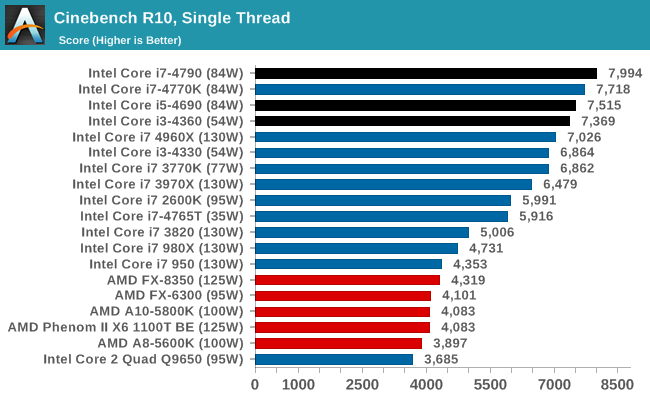

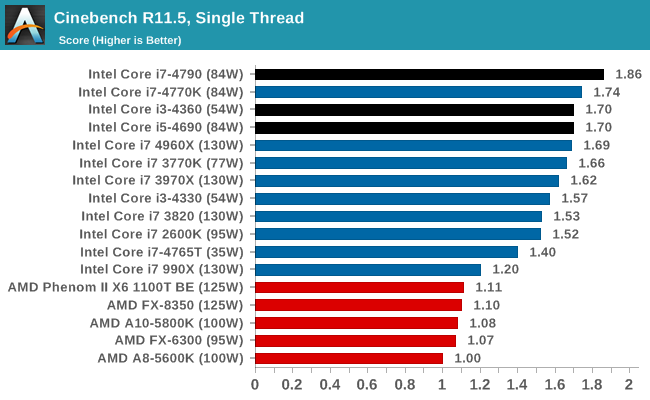
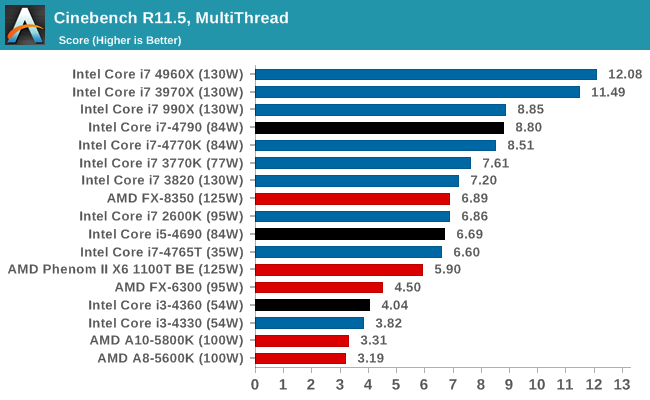

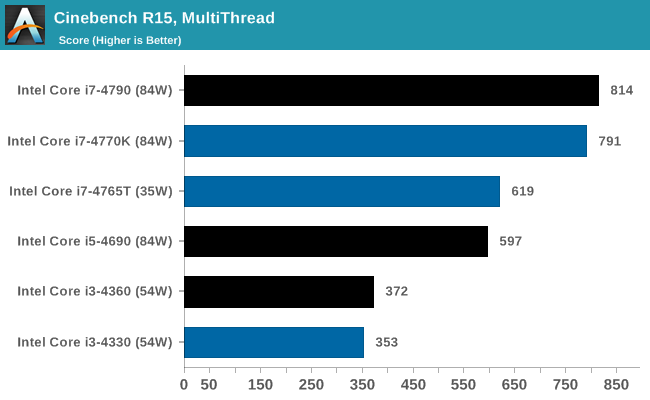
Video Conversion - x264 HD 3.03 Benchmark
Graysky's x264 HD test uses x264 to encode a 4Mbps 720p MPEG-2 source. The focus here is on quality rather than speed, thus the benchmark uses a 2-pass encode and reports the average frame rate in each pass.
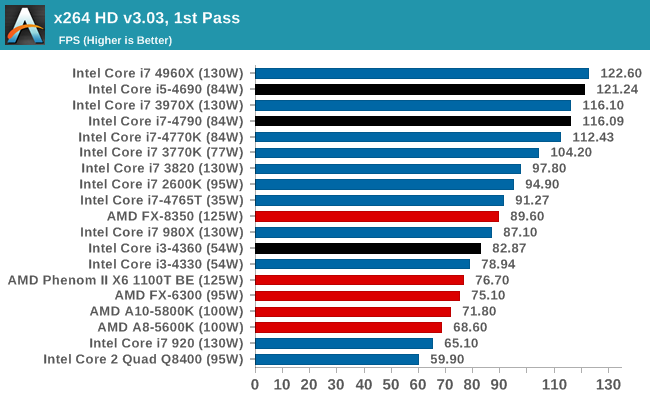

Encryption –TrueCrypt v0.7.1a: link
TrueCrypt is an off the shelf open source encryption tool for files and folders. For our test we run the benchmark mode using a 1GB buffer and take the mean result from AES encryption.
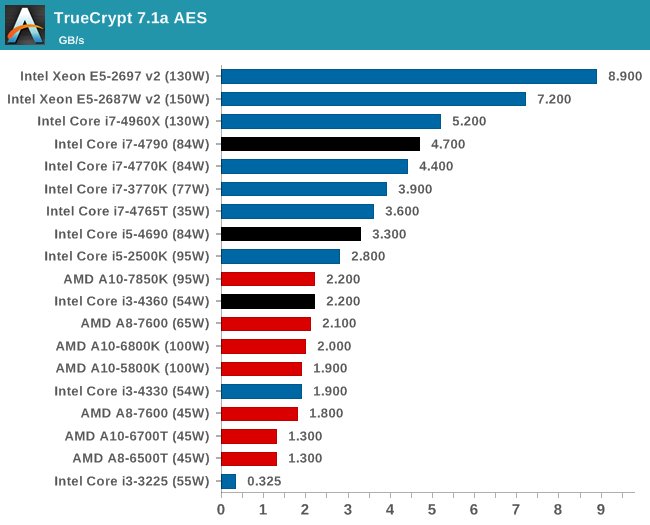
Synthetic – 7-Zip 9.2: link
As an open source compression tool, 7-Zip is a popular tool for making sets of files easier to handle and transfer. The software offers up its own benchmark, to which we report the result.
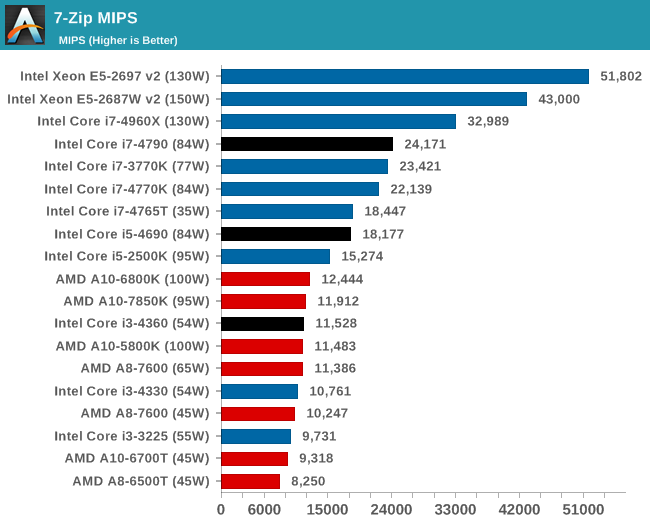
Rendering – PovRay 3.7: link
The Persistence of Vision RayTracer, or PovRay, is a freeware package for as the name suggests, ray tracing. It is a pure renderer, rather than modeling software, but the latest beta version contains a handy benchmark for stressing all processing threads on a platform. We have been using this test in motherboard reviews to test memory stability at various CPU speeds to good effect – if it passes the test, the IMC in the CPU is stable for a given CPU speed. As a CPU test, it runs for approximately 2-3 minutes on high end platforms.
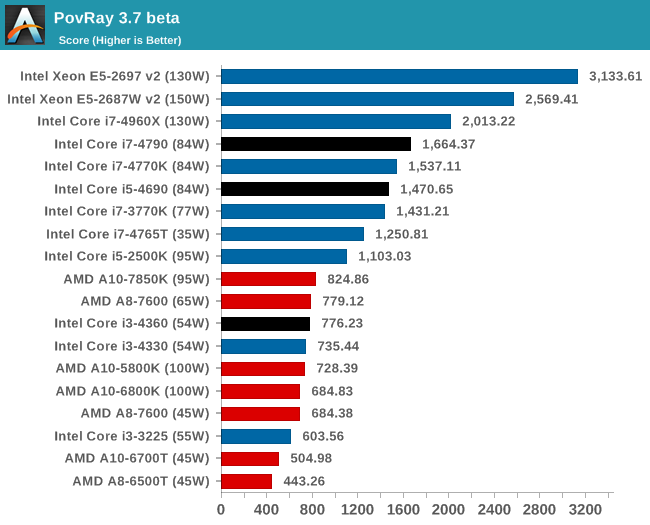
Console Emulation –Dolphin Benchmark: link
At the start of 2014 I was emailed with a link to a new emulation benchmark based on the Dolphin Emulator. The issue with emulators tends to be two-fold: game licensing and raw CPU power required for the emulation. As a result, many emulators are often bound by single thread CPU performance, and general reports tended to suggest that Haswell provided a significant post to emulator performance. This benchmark runs a Wii program that raytraces a complex 3D scene inside the Dolphin Wii emulator. Performance on this benchmark is a good proxy of the speed of Dolphin CPU emulation, which is an intensive single core task using most aspects of a CPU. Results are given in minutes, where the Wii itself scores 17.53; meaning that anything above this is faster than an actual Wii for processing Wii code, albeit emulated.
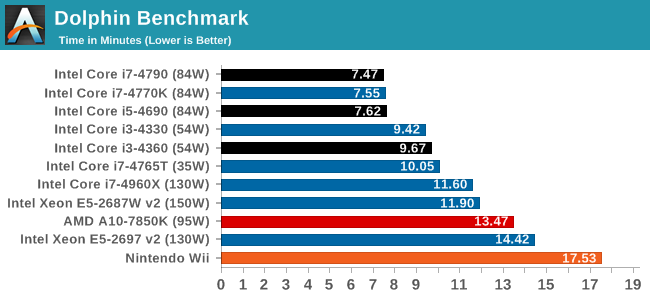
Dolphin relies very much on architecture as well as CPU single thread speed. It would also stand to reason that there is a small about of thread switching going on, given how far off the i3 and i7-4765T CPUs are.










130 Comments
View All Comments
willis936 - Sunday, May 11, 2014 - link
Man why are you reading anantech if you think redundant data collection is a waste of time? Verification of both results and of expectations in new products is valuable. Intel could call it a refresh after botching every wafer in the past six months and dump it into a new product line.DanNeely - Sunday, May 11, 2014 - link
This is the locked, non OC, portion of the Haswell refresh. The new unlocked chips have a rumored ETA of early next month.If you're not interested; go read something else instead. What you want isn't available yet.
Flunk - Monday, May 12, 2014 - link
Proving there is no credible difference is useful, maybe it will save some people a few bucks.nutjob2 - Sunday, May 11, 2014 - link
Intel is chasing a dying market, ie, those who are willing to pay for single threaded performance at any cost, and worry less about power consumption, in the desktop and server space.These people fall into two broad categories:
First there are gamers with more money than sense who spend hundreds or thousands each year on the latest CPU/motherboard/GPU that delivers a 5%-10% increase in framerate. Also other people who feel they need the latest and greatest for whatever reason.
On these people Intel dumps their hottest parts since they're not very concerned about power consumption, water cooling is a badge of honor for these guys.
Then there are the corporates who are visited by HP/Dell/etc salesmen and are told they need big, big iron so they can virtualise all their servers to "save money". That of course means they've created a single point of failure for all those servers so they need a machine with redundant everything and huge density. No-one has the heart to tell them they still have a single point of failure.
These people don't so much care about power consumption than the fact you can't cool or deliver power very well to multiple processors in a box, so Intel give them their somewhat cooler parts. Because most of the software they run is not very clever and largely single threaded they stick to Intel.
The smart corporate money is not buying any of Intel's overpriced CPUs instead they're sticking with their existing hardware and waiting for "cloud" providers to lower their prices. Why are they doing that? Because Intel is playing most of the above market for suckers, making them pay through the nose while they sell their best parts to Amazon, Google, Microsoft, IBM et all who pay a fraction of what everyone pays. Intel doesn't do this out of the kindness of their hearts but because they know that cloud providers will eventually replace many of their existing direct customers and because they don't care about single threaded performance (they're almost always using all their cores). Intel are milking their cash cows while they kiss up to the new big players, lest they start getting too friendly with AMD or ARM vendors who can make custom parts for them, just like the big players make their own motherboards, etc shutting out people like HP and Dell.
willis936 - Sunday, May 11, 2014 - link
Adding an extra 20 to product numbers is "chasing"?betam4x - Sunday, May 11, 2014 - link
Regarding your comments:1) Gamers don't spend 'hundreds of thousands of dollars every year' on PC components. Top of the line PC hardware can be had for under 3 grand. Typically the users who buy this years new hardware are the ones that skipped the past 1-2 generations of hardware.
2) Intel's parts aren't 'hot'. They are more power efficient than they've ever been. The performance per watt is among the highest in the industry.
3) Virtualizing does save money. Even if that server went up in flames, a backup of that VM is stored elsewhere so that it can be quickly brought back up on the backup server located in another rack. This means minutes of downtime instead of hours.
4) At my company we buy intel CPUs every day. We upgrade all of our machines every 3 years and often have to buy new machines for new employees. Of course, we do other 'crazy' things as well, like dual monitors, ample workspace, etc. Imagine that?
Gigaplex - Monday, May 12, 2014 - link
"Gamers don't spend 'hundreds of thousands of dollars every year' on PC components."They said hundreds OR thousands, not "of".
rajod1 - Friday, May 30, 2014 - link
Gamers as a group spend millions on upgrades not hundreds or thousands.maximumGPU - Tuesday, May 13, 2014 - link
Upgrade every 3 years, and new machines for new employees? I'd like to apply to a job in your company, tired of XP and pentium 4's in my current one.YuLeven - Wednesday, May 14, 2014 - link
Know that feel. I use a Celeron D here.